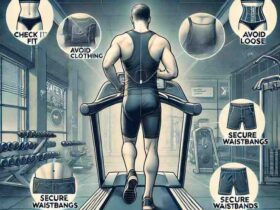Uncovering the Natural Approach to Treadmill Exercise: Walking Barefoot on Treadmill
Walking barefoot on treadmill reconnects us with natural gait benefits often lost to modern footwear. This practice enhances posture, alignment, and balance, reducing injury risk. It activates smaller foot muscles, boosting proprioception, coordination, and strengthening foot arches, helping prevent conditions like flat feet and plantar fasciitis.
Barefoot walking ensures a natural stride, lessening joint impact and potentially easing knee, hip, and lower back pain. Direct treadmill contact promotes even weight distribution, minimizing stress and serving as a therapeutic tool to aid recovery from foot or lower limb injuries by improving circulation and flexibility.
Safety is crucial—start slowly, gradually extend walking sessions, and keep the treadmill clean to avoid injuries. In summary, walking barefoot on a treadmill can significantly improve posture, balance, and foot strength, adding great value to any fitness regimen.
Understanding the Appeal of Barefoot Walking on Treadmill :
Understanding the appeal of walking barefoot on a treadmill involves recognizing the natural and health benefits it offers. Consequently, this practice enhances posture, balance, and foot strength.
1. Historical Perspective
Historically, human ancestors walked barefoot, shaping our foot’s natural structure and mechanics. Shoes are a recent evolution. Walking barefoot on a treadmill replicates ancestral conditions, enhancing posture, natural foot mechanics, and balance.
Therefore, embracing barefoot walking on a treadmill reconnects us with our evolutionary roots, providing numerous health benefits.
2. The Biomechanics of Barefoot Walking on Treadmill
Barefoot walking on a treadmill changes foot interaction with surfaces, enhancing arch function and body alignment. This practice promotes a natural gait, improving posture and balance, and activates smaller foot muscles for better sensory feedback, proprioception, and coordination. Walking barefoot on a treadmill adjusts body mechanics differently than walking with shoes, reconnecting us with natural movement patterns and providing numerous health benefits.

Image: Running barefoot on a treadmill.
The Benefits of Walking Barefoot on Treadmill :
Health and Fitness Advantages : The benefits of walking barefoot on a treadmill include enhanced posture, better balance, and stronger foot muscles. Consequently, it promotes overall foot health.
1. Enhanced Foot Mechanics
Walking barefoot on a treadmill encourages a natural foot motion, enhancing foot mechanics and reducing injury risk. This practice promotes a forefoot or midfoot strike, decreasing impact forces and stress on joints, ideal for those with joint issues. It also strengthens foot muscles, tendons, and ligaments, boosting overall foot health.
Enhanced sensory feedback from walking barefoot on a treadmill improves balance and proprioception. Incorporating this practice into your fitness routine can lead to better foot mechanics, reduced injuries, and improved health.
2. Strengthening Foot and Ankle Muscles
Walking barefoot on a treadmill strengthens foot and ankle muscles, which can weaken over time due to excessive shoe support. This practice activates smaller, stabilizing muscles, improving overall foot and ankle strength and reducing injury risks.
Additionally, walking barefoot on a treadmill enhances balance and proprioception as the feet directly sense and adapt to the treadmill surface. Incorporating this method into your routine can lead to stronger feet and ankles, boosting overall stability.
3. Improved Posture and Balance
Walking barefoot treadmill improves posture and balance by enhancing body awareness and natural feedback, which shoes often mute. This increased sensory feedback from the feet leads to better alignment and coordination. Additionally, walking barefoot on a treadmill activates stabilizing muscles, promoting a balanced gait and reducing fall risks. Incorporating this practice into your routine supports better posture, enhanced balance, and overall well-being, making it a valuable part of your fitness regimen.

Therapeutic and Psychological Benefits :
The therapeutic and psychological benefits of walking barefoot on treadmill include reduced stress and enhanced mindfulness. Consequently, it improves overall mental well-being.
1. Stress Relief and Sensory Stimulation
Walking barefoot treadmill offers therapeutic benefits like stress relief and sensory stimulation. The direct sensory feedback from the feet has a calming effect, reducing stress and enhancing mental well-being. Walking barefoot on a treadmill stimulates nerve endings that connect to the brain, promoting relaxation and grounding. Incorporating this practice into your routine can improve mood, reduce stress, and bolster mental health.
This sensory-rich experience supports psychological balance, making it beneficial for both mind and body.
2. Potential Pain Reduction
Walking treadmill can potentially reduce pain from foot ailments like plantar fasciitis by promoting a natural gait and reducing foot strain. This activity encourages proper foot movement, alignment, and muscle engagement, which can also alleviate pain in the knees and lower back. Incorporating walking barefoot on a treadmill into your routine may lead to decreased discomfort and improved overall foot health.
This natural exercise method supports both physical and psychological well-being, making it a beneficial addition to any fitness regimen.
3. Connection to Nature and Mindfulness
Walking barefoot on a treadmill fosters a connection to nature and promotes mindfulness, simulating the sensory experience of walking outdoors. This practice enhances body awareness, often diminished by footwear, and encourages individuals to focus on their movements and sensations. Barefoot on treadmill heightens awareness, promoting relaxation and reducing stress, which benefits mental well-being.
Incorporating this into your routine can deepen your mindfulness and connection to your body, supporting both physical and psychological health. This natural approach is a valuable addition to any wellness regimen.
Safety and Hygiene Considerations :
Safety and hygiene considerations for walking barefoot on a treadmill include keeping the surface clean and monitoring foot health. Consequently, this prevents infections and injuries.
1. Treadmill Surface
Safety and hygiene considerations are crucial when walking on treadmill, particularly concerning the treadmill surface. Ensure the treadmill belt is clean and free of debris that could harm bare feet. Regular maintenance of the treadmill is essential to provide a safe environment for barefoot walking.
Consequently, this involves routinely inspecting the belt for any sharp objects or wear and tear that might pose risks. Additionally, disinfecting the treadmill surface can prevent infections and keep it hygienic for barefoot use. Therefore, incorporating these safety measures can enhance the overall experience of walking barefoot on treadmill.
By ensuring a clean and well-maintained treadmill, individuals can enjoy the numerous benefits of barefoot walking without compromising their safety. This careful attention to hygiene and maintenance supports a healthy and effective exercise routine, making walking barefoot on a treadmill a secure and beneficial practice.
2. Hygiene Concerns
Safety and hygiene considerations are paramount when walking on treadmill, particularly regarding hygiene concerns. Bare feet can be more vulnerable to fungal infections and other pathogens commonly found on exercise equipment.
Consequently, proper cleaning of the treadmill before and after use is crucial to avoid health issues. Regularly disinfecting the treadmill surface can help prevent the spread of germs and ensure a hygienic environment for barefoot walking.
Additionally, using a personal mat or towel can add an extra layer of protection against contaminants. Therefore, incorporating these hygiene practices can significantly reduce the risk of infections when walking on treadmill.
By maintaining a clean and sanitized treadmill, individuals can safely enjoy the benefits of barefoot walking without compromising their health. This diligent attention to hygiene supports a healthy and effective exercise routine, making walking barefoot on treadmill a secure and beneficial practice.
3. Adapting to Barefoot Exercise
Safety and hygiene considerations are essential when walking barefoot on a treadmill, particularly regarding adapting to barefoot exercise. Transitioning from shoes to barefoot walking should be gradual to avoid overloading the muscles and tendons of the feet and legs.
Consequently, starting with short sessions and gradually increasing the duration can help the feet adapt safely. This approach prevents strain and potential injury, ensuring a smoother transition to barefoot exercise. Additionally, paying attention to any discomfort or pain during the process is crucial.
Therefore, incorporating rest days and varying the intensity can support the adaptation period. By taking these precautions, individuals can safely enjoy the benefits of walking barefoot on treadmill. This careful and gradual approach helps build strength and resilience in the feet, promoting long-term foot health.
Ultimately, walking barefoot becomes a safe and effective practice, enhancing overall well-being while minimizing injury risks.
Best Practices for Barefoot Treadmill Walking :

Here’s the image depicting best practices for barefoot treadmill walking in a serene home gym setting. You can see the person walking barefoot on the treadmill, surrounded by a peaceful, natural atmosphere with plants, a yoga mat, and dumbbells nearby, emphasizing a holistic health approach.
Best practices for walking barefoot on treadmill involve starting slowly and increasing duration gradually. Consequently, this helps build strength and prevents injuries.
1. Starting Slowly
Best practices for walking on a treadmill emphasize the importance of starting slowly. Begin with short, low-intensity sessions to build tolerance and strength in your feet and legs. This gradual approach allows muscles and tendons to adapt without overloading.
Initially, aim for sessions of 5 to 10 minutes, paying close attention to any discomfort or pain. Consequently, if discomfort occurs, adjust or rest as needed. Gradually increase both the duration and intensity of workouts to build endurance and strength safely. Incorporate rest days to allow recovery and prevent overuse injuries. Listening to your body and adjusting your routine are essential steps in this transition.
Additionally, maintaining proper form and technique during barefoot treadmill walking is crucial to avoid injuries. By following these best practices, walking barefoot can become a safe and effective part of your fitness routine, promoting overall foot health and strength.
2. Monitoring Foot Health
Best practices for walking barefoot on a treadmill include closely monitoring foot health. Pay attention to any signs of discomfort or injury, such as calf strain, Achilles tendinitis, and blisters. Start with short, low-intensity sessions and gradually increase duration and intensity. If you notice pain or discomfort, reduce workout intensity or take a break to recover.
Regularly inspect your feet for blisters, cuts, or other issues. Incorporate proper stretching routines before and after treadmill sessions to maintain flexibility and reduce injury risk. Staying hydrated and maintaining foot hygiene are also important to prevent infections.
By following these best practices and monitoring your foot health, walking on treadmill can be a safe and beneficial part of your fitness routine. This mindful approach ensures you enjoy the numerous benefits while minimizing the risk of injury.
3. Incorporating Variety
Best practices for walking barefoot on treadmill include incorporating variety into your routine. Mix up your sessions with periods of both shod and barefoot walking to help your feet gradually adapt. This balanced approach strengthens different muscle groups and prevents overuse injuries. Consequently, alternating between shod and barefoot walking promotes overall foot health.
Additionally, consider adding different types of exercises, such as stretching, strength training, and balance exercises, to enhance the benefits of walking barefoot on a treadmill. These activities support foot flexibility, improve muscle strength, and boost overall fitness.
Moreover, varying workout intensity and duration prevents boredom and maintains motivation. Incorporate intervals of high and low intensity to challenge your feet and body in different ways. Therefore, mixing up your routine not only promotes better foot health but also contributes to overall fitness and well-being.
By incorporating variety in your treadmill walking routine, you maximize the benefits and minimize injury risks.
Long-term Strategies for Success :
1. Developing a Routine
Developing a consistent routine is key for success with walking barefoot on a treadmill. Start with short sessions and gradually increase intensity and duration to safely build foot and leg strength. Establishing regularly scheduled sessions helps form habits and maintain fitness goals. Track your progress to adjust and challenge yourself appropriately, avoiding injuries.
Include rest days to prevent overuse injuries and mix in exercises like stretching and strength training to support overall foot health. A well-planned routine ensures long-term success and makes walking on treadmill a sustainable and beneficial part of your fitness regimen.
2. Listening to Your Body
Long-term success in walking barefoot on a treadmill involves listening to your body and adjusting accordingly. If you experience discomfort or pain, reduce intensity or duration, and consider using cushioned footwear for recovery. Incorporate rest days to allow muscles and tendons to heal.
Adjust your walking technique or include supportive exercises to enhance your experience. By tuning into your body’s signals and adapting your routine, you can prevent injuries and ensure a safe adaptation process. This mindful approach helps build strength and resilience, making barefoot on treadmill a sustainable and beneficial part of your fitness regimen.
3. Seeking Professional Advice
Achieving long-term success in walking barefoot on a treadmill involves seeking professional advice, especially for those with pre-existing foot conditions or persistent pain. Consulting a healthcare provider ensures your regimen is safe and customized. They can assess foot health, prevent potential issues, and provide tailored recommendations for safe progression.
A foot specialist can offer valuable insights on proper technique and foot care, suggesting exercises and stretches that complement your treadmill walking. By seeking expert guidance, you can maximize the benefits and minimize risks, supporting your overall well-being and long-term success in walking on a treadmill.
FAQ’s about Barefoot Walking on Treadmill :
1. What are the benefits of barefoot walking on a treadmill?
Barefoot walking on a treadmill promotes better posture, enhances balance, and strengthens foot muscles. Consequently, it reduces injury risks and improves overall foot health.
2. Is barefoot walking on a treadmill safe?
Yes, it is safe if done correctly. Start slowly, gradually increase the duration, and ensure the treadmill surface is clean and free of debris.
3. How does barefoot walking on treadmill improve foot health?
Barefoot walking encourages the use of smaller muscles in the feet. This strengthens the arches and reduces the likelihood of developing flat feet or plantar fasciitis.
4. Can barefoot walking on a treadmill reduce joint pain?
Yes, it can reduce joint pain. The natural stride promoted by barefoot walking reduces impact on knees, hips, and the lower back, alleviating pain.
5. How often should I practice barefoot walking on treadmill?
Start with short sessions and gradually increase the frequency and duration. Listen to your body to avoid overexertion and ensure a safe progression.
6. Can barefoot walking on a treadmill aid in rehabilitation?
Yes, it can aid in rehabilitation. It improves circulation and flexibility, which are crucial for recovering from foot or lower limb injuries.
7. Are there any precautions for barefoot walking on treadmill?
Ensure the treadmill surface is clean and free of sharp objects. Start slowly and gradually increase the duration to allow your feet to adapt safely.
8. Does barefoot walking on a treadmill improve balance and coordination?
Yes, it improves balance and coordination. The enhanced sensory feedback from the ground leads to better proprioception and coordination.
Conclusion: Reaping the Benefits While Mitigating Risks
Walking on treadmill offers significant health benefits, enhancing physical and psychological well-being while restoring natural foot function. This practice improves posture, alignment, and balance, reducing injury risk by activating smaller foot muscles and boosting proprioception and coordination. It also strengthens foot arches, preventing conditions like flat feet and plantar fasciitis.
Barefoot walking encourages a natural stride, lowering joint impact and alleviating pain in knees, hips, and lower back. Direct treadmill contact ensures even weight distribution, minimizing stress and aiding recovery through improved circulation and flexibility.
To maximize benefits safely, start slowly, gradually increase duration, and keep the treadmill clean. In conclusion, walking barefoot on a treadmill optimizes posture, balance, and foot strength, providing substantial health rewards while effectively mitigating risks.











Leave a Review